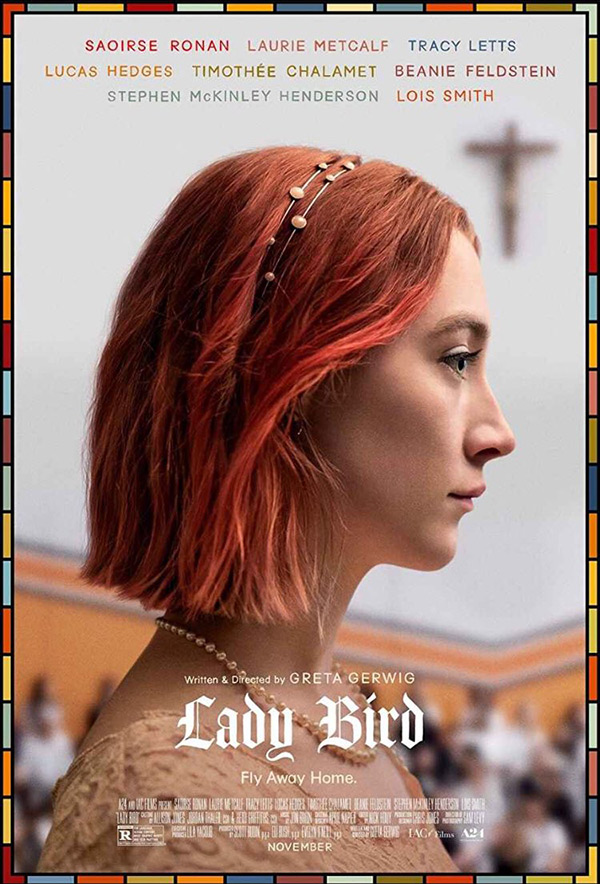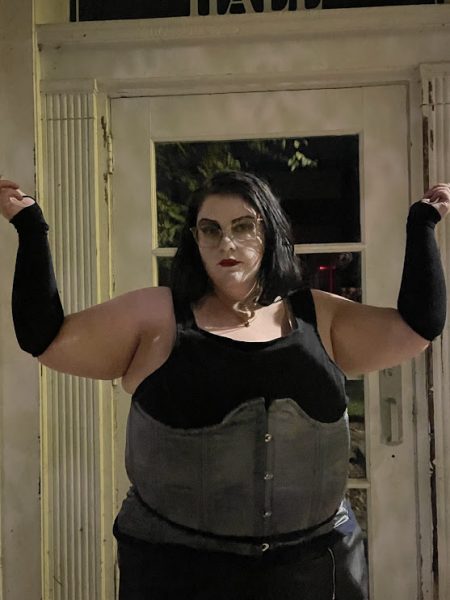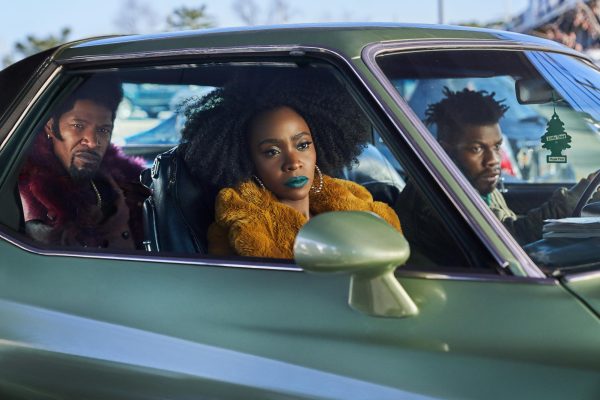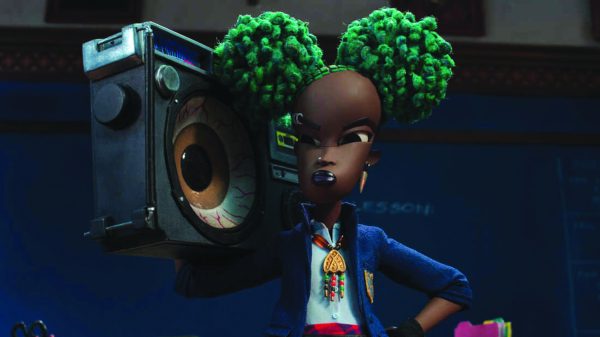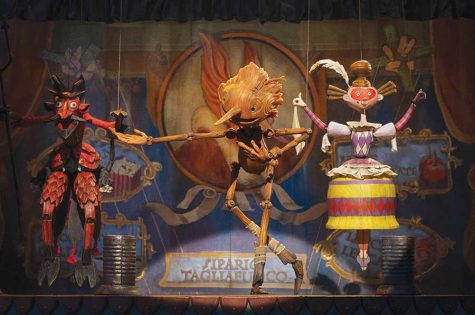“Lady Bird” provides a tragicomic take on coming of age
Has your mother ever made you want to forcefully jump out of a moving vehicle? Self-christened “Lady Bird” starts out the movie of her name by doing exactly this. The neon pink arm cast she earns from this choice brightly stands out throughout the first act of the film alongside her bluntly cut, messy pink hair, contrasting with her white and navy Catholic school uniform.
Christine “Lady Bird” McPherson is portrayed by the simultaneously stoic and vulnerably expressive Saoirse Ronan, whose Oscar-nominated performance at age 12 in “Atonement” paved the way for her critical success in films such as Peter Jackson’s “The Lovely Bones” and Wes Anderson’s “The Grand Budapest Hotel.”
“Lady Bird” is set in Sacramento, California, between the fall of 2002 and the fall of 2003, an interesting time before cell phones were permanent fixtures in teenagers’ hands and MTV was not completely dead. Lady Bird herself is stuck in this point in her life as a senior at a Catholic, all girls high school who desperately wants to leave the familiarity of her home town and experience real culture, as she puts it.
Lady Bird is a beautiful representation of all the contradictions that define a teenager desperately trying to take that first step into adulthood. She is brash, forcefully quirky, impatient, self-centered and skeptical, yet also forcefully poised in her words and actions, enthusiastic and scathingly honest with those she cares about.
This is director Greta Gerwig’s first fully scripted feature film she has directed alone. As a first-time director, Gerwig, who is a native of Sacramento, displays an uncanny knack for understanding her characters and crafting a film that truly makes you believe in them and empathize with them. The characters and their personalities all establish themselves as not just soundboards for Lady Bird’s character to bounce off, but completely independent and clearly defined, each having their own journey throughout the film alongside her.
Her melancholy yet warm, humorous father helps balance out her mother’s harsh nature, and serves as a safe and unjudging presence for Lady Bird to seek out. One of my favorite relationships throughout the film is between Lady Bird and her closest female friend, the wonderfully sweet Beanie Fieldstein (Julie Staffens), which starts out like an average high school friendship, but quickly develops deep and complicated nuances that underscore the importance of forgiveness and the strength of female bonds.
Lady Bird’s relationship with her mother, Marion McPherson (Laurie Metcalf), whose balance of scathing remarks and harsh pressure for her daughter to see the world more clearly is punctuated by brief moments of tenderness and understanding. It is the heart of the film.
The first scene is a wonderful example of the humorous absurdity of their mother-daughter dynamic. Mother and daughter are moved to tears together while listening to the conclusion to the audiobook of “The Grapes of Wrath” during a long distance college tour road trip. This close moment between them quickly devolves into an argument, scathing remarks being thrown back and forth as the tension of what Lady Bird longs for — leaving Sacramento to go to college in New York — collides with her mother’s blisteringly realistic remark that she would not get into those particular colleges anyway.
Gerwig’s writing and the actors’ ability to express the most important non-verbal emotions truly shines in these moments. I was reminded so strongly of arguments that my mother and I have that I could not help laughing while also feeling the familiar pit in my stomach as the conversation turned into an argument. Never had I seen on-screen arguments between mothers and daughters that better captures the tension and mixed emotions of trying to not just communicate clearly, but communicate clearly enough so that each other really “gets it.”
I am a 90s kid, and despite not quite being a teenager during the early 2000s, I felt immediately comfortable and familiar with the settings and scenarios that Lady Bird faces. As a coming of age story and a teenage comedy, “Lady Bird” encompasses all of the daily plights of high-school: math class, the college admissions process, judgment from female classmates, prom, and school plays, while also hitting every big milestone as she tries to solidify her identity. She falls in love for the first time, has sex for the first time, struggles with her friendship with her best friend, seeks out affirmation with the wrong people, has her heart broken, and eventually comes out stronger at the end of it all.
To some, “Lady Bird” may sound like an average coming-of-age story. And while “Lady Bird” does wade into familiar territory with the themes and issues it is addressing, Gerwig uses this familiarity to aid in enhancing the delicate nostalgia this film so masterfully elicits. The characters, dialog, and situations are extremely heartfelt — familiar archetypes, yet unique. Their journeys are familiar, yet also unpredictable and ultimately thrilling to see develop.
I saw myself in Lady Bird’s shoes. I walked with her through every warm, hilarious, confusing, heartbreaking, ridiculous and excruciating moment. Throughout the film I screamed softly, cried openly, cringed, laughed until I cried, gasped, and smiled countless times. It was a delicious roller coaster of cathartic moments.
Running at only one hour and 45 minutes, this film had so many little nuances, one liners, shared looks, split seconds of physical comedy and moments of clarity the characters experience that this review cannot even touch upon. The city of Sacramento is bathed throughout the film in a beautiful, nostalgic light, with the film not only serving as Lady Bird’s journey, but also as a quiet love letter to the city that Gerwig grew up in. “Lady Bird” was truly a delight, with scenes jumping from tender to harsh, cringe-inducing to enlightening, exhilarating to soul crushing, and I loved every moment of it.
“Lady Bird” is a coming of age story. It is a family drama. It is an absurdist comedy. It is a love letter to a place and a time. It is about mothers and daughters and the complicated opposing lenses through which each views the world. And it is about how if they were to take a moment to try to see through each other’s eyes, they may come to a better understanding of the type of love they have for each other.
Ultimately, Lady Bird’s journey is about reconnecting with those you love. It is about growing and being confused and trying to mutually understand as best we can that we are all flawed and we all are struggling with who we are and where we are at in life. “Lady Bird” is truly a wonderful film, filled with flawed characters that remind everyone that, at one point, none of us had a clue who we wanted to be.


